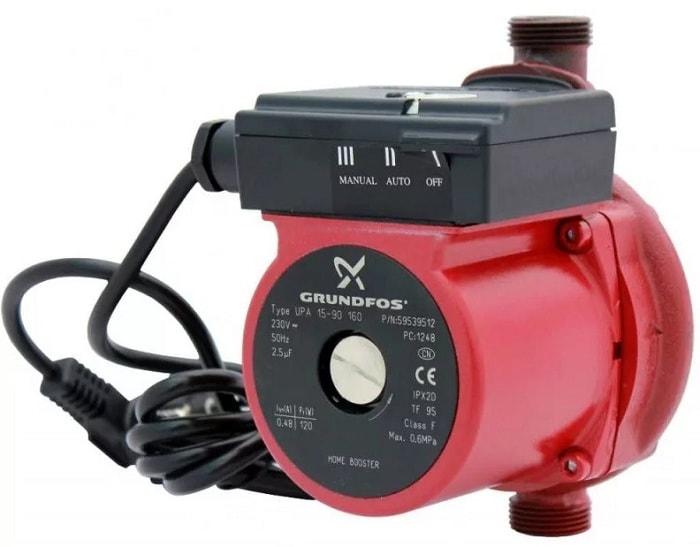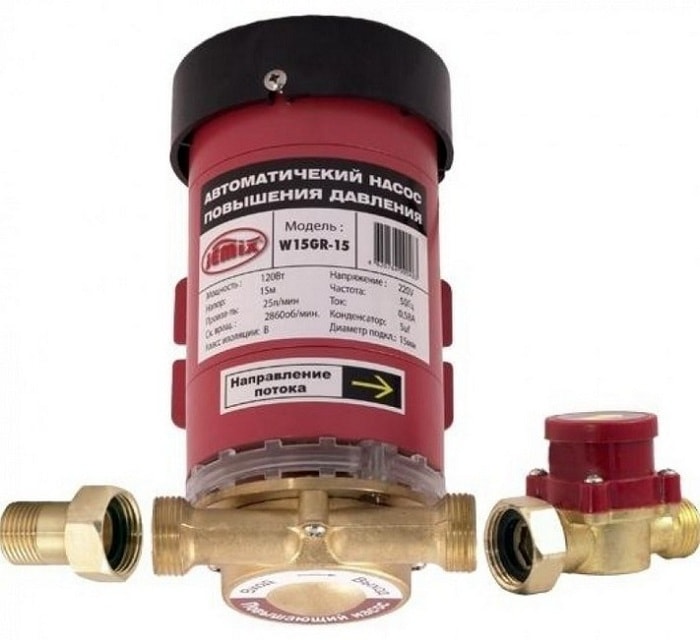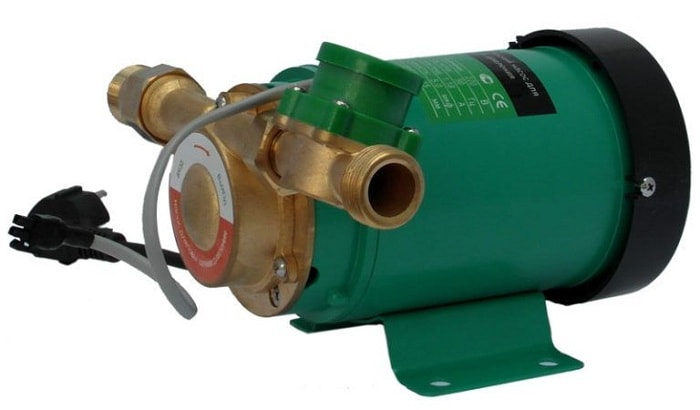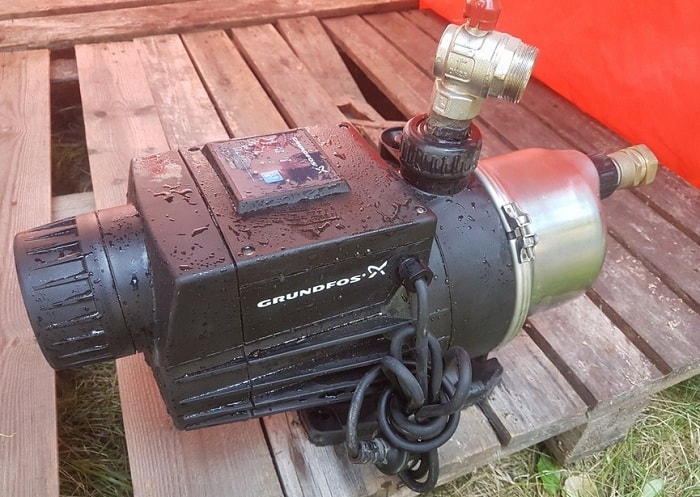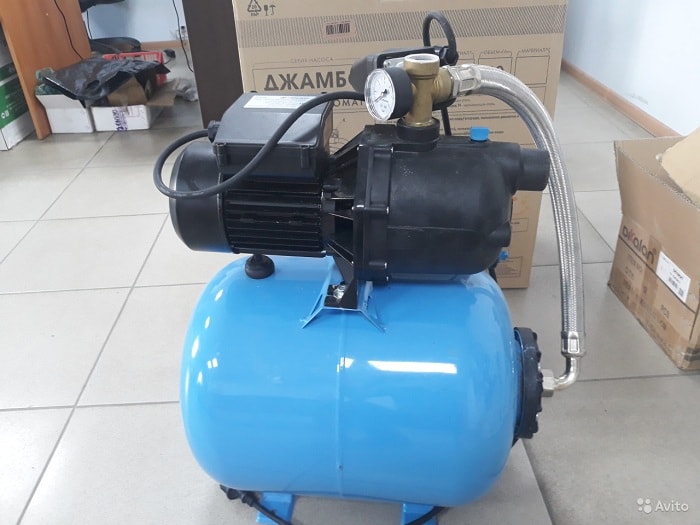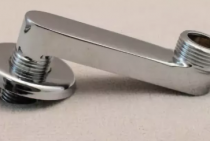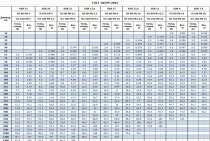Installing a boost pump
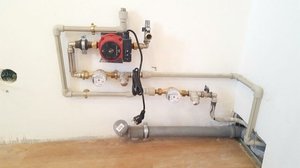
With any installation of a pressure boosting system, it is imperative to consider the possibility of bypassing or dismantling the device.
Installing a booster pump at home for the hot water of the heating system is not particularly difficult for an experienced home master. But still, when installing the unit, one should not forget about a number of nuances of this work:
- Wherever the device is installed, it is advisable to mount a strainer in front of it, since solid particles entering the bearings can damage the device or reduce its efficiency.
- After the unit, it is recommended to install a non-return valve in the system to protect against possible water hammer and prevent the reverse flow of water when the device is turned off.
- In conventional hot heating systems, it is desirable to place the pump at the point with the lowest temperature, i.e. in close proximity to the boiler.
- To avoid the possibility of breaking the water flow (air entering the system), it is necessary to mount the pump in front of the supply manifold. If the unit is equipped with an air valve, the air must be bled from the system.
- Be sure to place an electrical outlet near the installation site of the unit, so that the device turns on without tension on the cord. The outlet must be grounded.
- Before starting the pump, make sure that the system is completely filled with water, as even short-term idling can damage the device.
- Thoroughly flush the system with clean water before starting up to avoid the ingress of solid particles.
Remember that when choosing a device for increasing the pressure in the water supply system, it is not recommended to focus on models of unknown manufacturers. It is better to purchase a quality unit that will last a long time without any outside interference in its operation.
Without any fear, it is better to buy branded goods of European production WILO, Hoffmann, DAB, Ebara. Among Russian manufacturers, the company "Dzhileks" can be distinguished.
How to install a pump to increase water pressure
The connection of the circulation booster and the preparation for operation of more complex in design pumping devices, equipped with a hydraulic accumulator, differ significantly.
Connecting the circulation booster
Installation of a circulation unit to increase water pressure in a multi-storey building is carried out in the following order:
- A grinder or a special device for plastic pipes on the inlet line cuts out a piece of pipe corresponding to the installation size of the device;
- In accordance with the material of the pipeline, connecting fittings are mounted. If metal pipes are used, either a welded joint or threaded drives are used; if the pipes are plastic, a special soldering iron is used;
- Using the nuts included in the delivery set, the product is mounted in the trunk.
Installation of a suction pump module with a hydraulic accumulator is a much more laborious process. To begin with, we list the main modules available in a typical injection system:
- Self-priming module;
- storage capacity;
- Automatic control system;
- Primary filter that prevents various abrasive fine contaminants from entering the system;
- Plumbing fittings, pipelines and flexible hoses.
To prevent the outflow of water from the pump housing when the power is turned off, a shut-off valve is provided in front of the inlet pipe. In high-rise buildings, the supply line acts as a source of water; in the private sector, this is most often its own well or well.
The method of connecting the injection unit in the private sector
- The installation should be installed in the immediate vicinity of the water intake;
- The temperature at the installation site should not fall below +5 C;
- Contact of installation modules with walls is not allowed;
- The place of installation must allow the maintenance and repair of the units.
There are several most common options for installing a pumping station with a hydraulic accumulator:
- Directly in the house;
- In the basement or basement;
- In the well;
- In a caisson;
- In a special insulated building.
Each of these options has its own advantages and disadvantages, so the choice of installation depends primarily on the layout of the site and the features of the building. After choosing the installation site, proceed to the installation of the station, which consists of the following main steps:
Preparatory activitieswhich include:
a) Arrangement of a site for the installation of equipment. The foundation must be strong and provide reliable fastening of the apparatus;
b) Digging trenches for laying pipelines;
c) Providing power
2. Installation of the water intake system. Depending on the modification of the pump used, there are:
a) standard scheme, with a surface pump unit and a built-in ejector. In this case, the design is a polypropylene pipe, with a check valve connected through a special coupling with a built-in coarse filter;
b) Using an external ejector. With this design, a check valve with a coarse filter is installed on the inlet pipe of the ejector;
c) With submersible pumpequipped with a strainer. In this case, it is sufficient to connect the non-return valve and the supply line.
3. Installation of surface modules. At this stage, it should be remembered that the connection of each subsequent element should be made using ball valves and check valves. This design will provide the possibility of maintenance and repair of individual pump modules without resorting to draining water from the entire line;
4. Initial start-up of the station is made after filling with water through a special neck located on the top panel of the working chamber.
https://youtube.com/watch?v=5c39kXyw3uM
Before starting any step-up generator, make sure that the ground is present and in good condition!
Pump selection
Modern manufacturers offer many different models of booster pumps for water supply.
Models WILO, Jemix, Aquatica look very similar to each other, however, in many respects they have a big difference, which you need to pay special attention to when choosing a device
The best option for increasing the pressure in the domestic water supply system is to use built-in pumps with a wet rotor model WILO. The type of installation is selected depending on the planned location of the tie-in of the booster pump into the water supply. Of course, it is better to buy a pump with multi-stage speed control, but the price of such units is much higher than single-speed models. In country water supply, single-stage pumps are more often used.
The body material is also of great importance. Manufacturers offer pumps made of stainless steel or cast iron.A stainless steel case is more practical, but, accordingly, the price will be higher. It is better to buy a WILO product with an impeller made of brass or bronze. The plastic impeller belongs to a cheaper price segment, but during operation they are more likely to break down.
What is a booster pump
A booster electric pump is a unit with an electric motor and an impeller that pushes water into a pipe connected to it, resulting in an increase in pressure. Often, devices are installed at the inlet of household appliances: gas water heaters, water heaters, automatic washing machines, dishwashers, high-tech whirlpools, which require water with a certain pressure at the inlet for normal operation.
The principle of operation of the booster electric pump
Many booster pumps for water supply work on a centrifugal principle with the movement of liquid by an impeller with blades mounted on an electric motor shaft. Water is supplied through a branch pipe located on the central axis of the shaft and is pushed out by the wheel blades through the side outlet.
Electric pumps that increase the pressure of water in the water supply usually operate in an automatic on and off mode, which is controlled by a built-in reed flow switch. In the idle state, in the absence of water flow in the pipeline, the unit is turned off, as soon as the tap is opened, the water begins to move through the pipes, the relay is activated and the booster pump is turned on.
Many users and authors of Internet articles confuse a booster pump for water supply with a circulation pump installed in the heating systems of private houses. Although they structurally look almost the same and have a similar principle of operation, circulation types are designed for continuous supply of liquid to a height with constant maintenance of coolant pressure in the system and are turned off in two cases: when a thermal switch is triggered, indicating an excess of coolant temperature, and when the pressure switch is turned on ( rarely used), signaling too much pressure of the working fluid in the pipes.

Rice. 2 Micro-rotor electric pump in section
Small-sized centrifugal booster electric pumps are manufactured using two technologies: with a wet and dry rotor. In dry-rotor devices, the shaft of an electric motor with an impeller is separated from its rotor and stator winding by a highly hermetic mechanical seal. This modification is characterized by a high efficiency of about 70%, usually an impeller is placed at the end of the housing to cool the engine. Dry-rotor modifications, in comparison with wet-rotor types, have large overall dimensions, have higher power and productivity indicators, are not critical to cleanliness and the absence of water due to air cooling of the electric motor. But their main drawback is the high noise level, which significantly limits the scope of application in private water supply systems.
In modifications with a wet rotor, the latter is separated from the magnetic circuit of the electric motor by a thin-walled glass, in which it rotates, being held on end bearings. The glass and bearings are filled with water - this ensures silent operation and effective water cooling. Thanks to this design, wet-rotor units have a low efficiency of about 40%, cannot operate in the absence of water cooling (they definitely need winding protection from idling), and have small overall dimensions. Their work requires a clean environment, and the main advantage is the quietness of the stroke, which is often decisive when using them in individual water supply.

Rice. 3 The device of the dry-rotor unit
Vortex booster pumps
On the market there are pumping modifications and a vortex principle of operation, they are easily distinguishable by the suction and pressure pipes placed on the same line on the side of the end part of the housing. Their impeller is made in the form of an impeller located on the motor shaft, water is sucked in through one of the side pipes and pushed out by the blades through the opposite outlet. To reduce hydraulic losses and increase efficiency, the gap between the blades of the vortex wheel and the walls of the working chamber is made minimal, so models of the vortex principle of operation are much more demanding on water purity than their centrifugal counterparts.
How to choose boost equipment
To avoid operational problems (for example, the pump does not build up pressure), when choosing a model, evaluate it according to the following characteristics:

Wiring diagram for booster pump
- compliance with performance requirements;
- installation type, service parameters;
- in what range does the pressure generated for the pump fluctuate;
- engine parameters and type of its cooling;
- the possibility of continuous operation;
- operating modes;
- availability of speeds;
- feed and pressure indicators;
- maximum flow rate and plant throughput.
Features of installation and connection
Installation and connection of an individual booster pump is simple and does not require the involvement of specialists. First you need to make a marking on the selected section of the pipeline, which corresponds to the length of the pump assembly with adapters.
Next, it is necessary to drain the water from the system - shut it off and open the taps so that the residues leave the pipeline. The pipe is cut in accordance with the markup, a thread is applied to the outer surface of the pipes, with which adapters are mounted. At the last stage, fittings are screwed into the adapters and the valve, the pump is installed, the joints are sealed.
It is recommended to choose the place of the cut in close proximity to the shield and the outlet. The shield must be equipped with a separate machine that regulates the operation of the pump, the shield and the pump are connected to each other by a three-wire copper cable.
Booster pump installation
All small-sized booster pumps are installed in a pipeline break, so their inlet and outlet pipes are located on the same line. The models differ only in the installation distance between the fittings and their diameter, the connecting pipes in the vast majority of cases have an American type design. Technically, if you have the appropriate plumbing equipment for soldering or crimping threaded fittings, installing a booster pump is not particularly difficult and consists of the following procedures:
- In an easily accessible place, a pipe segment is cut out of the pipeline, equal in length to the installation dimension of the unit.
- If the pipeline is metal, threads are cut at the ends of the cut pipes, an adapter from polymer to metal is soldered into polypropylene, threaded fittings with an external thread for an American pump are pressed into metal-plastic.
- Next, a pump is installed to increase the pressure in the pipe rupture in accordance with the operating instructions, it is often screwed to the threaded pipes with American union nuts.

Rice. 13 Connection diagrams for pumping pumps
Connection diagram - recommendations
When determining the location for the optimal location of the pump, it is guided by the following considerations:
- For the correct operation of household appliances in the form of a boiler, washing machine or dishwasher, the pump is placed directly in front of them.
- If the house has a storage tank located in the attic, paging is placed at its exit.
- As with the installation of circulation units, in the event of an electric pump failure or removal for repair and maintenance work, a bypass with a shut-off ball valve is provided parallel to it.
- When installing a pump in apartment buildings, it is likely to leave residents without water in the riser, dramatically increasing the volume of its consumption when the pump is turned on. In this situation, it is necessary to provide for the placement of storage tanks in the apartment, which are more practical to hang from the ceiling.
- Many, when installing more powerful units in a line, do not get the desired result indicated in the passport data. Not knowing the laws of hydrodynamics, they do not take into account the increased hydraulic losses in the pipeline with an increase in the volume of pumped liquid - to reduce them, it is necessary to change the pipes to a larger diameter.

Rice. 14 Installation of booster pumps in the internal water supply
Booster electric pumps are usually installed in apartments or private houses when using public water supply networks, whose services do not fulfill their obligations to create working pressure in the system. Standard wet rotor household units increase the pressure by an average of 0.9 atm. To obtain a higher figure, it is necessary to install a centrifugal electric pump, a pumping station or an installation with frequency control of the impeller rotation speed (the best, but too expensive option).
The device and principle of operation of the pump to increase water pressure
Depending on the design of the impeller and performance, the principle of operation of booster systems may have some distinctive features.
Circulation centrifugal pump
The principle of operation of the pump is based on the creation of excess pressure at the periphery with simultaneous discharge in the center of the working area. The liquid is ejected through the outlet pipe under the action of the resulting excess pressure, and suction occurs due to the resulting vacuum.
Centrifugal self-priming station
The principle of operation of such systems is similar to the principle of operation of a centrifugal circulation pump, the main differences are in the power of the electric motor, overall dimensions and the presence of a hydraulic accumulator, which significantly increases the stability of the system.
Whirlpool self-priming station
Due to their design features, vortex pumping stations are able to provide outlet pressure 3-5 times higher than centrifugal counterparts and are not sensitive to airing. However, at the same time, such installations require a high degree of preliminary cleaning of the working environment and have a low efficiency.
In addition to technical characteristics, correct installation is important for ensuring high efficiency of pumping units.
When do you need a booster pump?
The water pressure at the inlet of the internal water supply in a private house with individual water supply is determined by the settings of the main automation element - the pressure switch, the highest standard threshold of which, when manually adjusted, does not exceed 5 bar. Therefore, it makes no sense to install a booster pump in a private house with an autonomous water intake - with an insufficient supply volume, it is cheaper and easier to install a large-capacity storage accumulator. A similar picture is observed in apartment buildings - there the water pressure is fixed and maintained at the desired level by utilities. But sometimes in apartments and private houses the following situations arise when it is necessary to install booster electric pumps in the water supply system:
a). With autonomous water supply, water resources are taken from borehole or well sources, using submersible well, borehole electric pumps or surface installations.Each water supply unit has certain technical characteristics, the main of which are pressure (indicated in meters) and pumping volume (in passports, the value is usually indicated in cubic meters per hour).
The pressure is the determining criterion for the indicator of the distance to the point of water consumption and the depth of immersion of the unit, usually 1 m is equated to the same 1 m of a vertical column and 10 m horizontally. If the well is located at a great depth or the distance to the house is large, the pressure created by a low-power electric pump (errors in the calculations when choosing, a decrease in performance during operation, the impossibility of replacing a worn-out unit with a new one) is not always enough to transport an acceptable volume of water per unit of time for the required distance. In this situation, a booster electric pump can be installed in the external line.

Rice. 4 Vortex electric pump and its principle of operation
c). Violation of their obligations by public utilities leads to the fact that the pressure in apartments (especially on upper floors or during peak hours) may be too low for the normal functioning of sanitary appliances, household appliances, and household needs. In this situation, the owner can install a low-power pump to increase the pressure in the water supply (mainly at the inlet of household appliances), which starts its work when water is consumed.
Types of booster pumps for water supply
Such pumps cannot create pressure from scratch, they increase the water pressure that exists in the system. This device raises the pressure by 1–3 atmospheres by pumping water after inserting it into an existing water supply. Pumps that increase water pressure differ in several ways.
By type of cooling
- Pumps with a dry rotor have a high efficiency. At the same time, the disadvantage of such devices is considered to be an increased noise level and large dimensions of the device.
- Glandless pumps are small in size and have a low noise level. But in work they are less effective, although they are 100% suitable for increasing the water pressure in the home water supply system. These devices are cooled by a stream of cold water flowing through the pump.
By installation method
- Horizontal pumps cut into water pipes that are located in the horizontal plane of the water supply system.
- Vertical devices are installed on the vertical risers of the system.
- Combined are installed in any position of the pipes of the water supply system.
By type of management
- Manual models are permanently switched off or on. Such a device turns on when it is necessary to increase the pressure in the system. The main thing is that there is a small pressure, because in the absence of water, the pump can simply burn out from overheating. Shutdown is made by the owner manually, after carrying out one-time operations.
- With automatic control, an installed special sensor gives a signal to turn on the pump when the need arises. In the absence of water in the system, the same sensor turns off the pump, which avoids overheating and failure.
- In combined models, switching between operating modes occurs using a special switch.
By availability of speeds
- Single-speed models can pump water at one shaft speed.
- Multi-speed operate with different intensity, which depends on the required amount of water flow.
By type of constructive solution
- Vortex units have high performance, but high noise levels and require special piping.
- Embedded structures are compact in size, but have a low level of performance. They are usually built into the supply pipeline.
Overview of the best pumps to increase water pressure
Owner reviews and sales statistics clearly show that the following models are most in demand:
Pump booster systems of "wet" type:
GrundfosUPA 15-90 (N)
Main performance characteristics:
|
Name |
Units |
Meaning |
|
Power consumption |
Tue |
120 |
|
Innings |
m3/h |
1,5 |
|
pressure |
mvs |
8 |
|
Maximum coolant temperature |
WITH |
+ 60 |
Advantages:
- Ease of operation and maintenance;
- Quality assembly;
- Long service life (warranty - 3 years, full - at least 10 years);
- Use of materials resistant to corrosion;
The average price is 7.5 - 12.5 thousand rubles.
Wilo PB-201EA
Main performance characteristics
|
Name |
Units |
Meaning |
|
Power consumption |
Tue |
340 |
|
Innings |
m3/h |
3,4 |
|
pressure |
mvs |
15 |
|
Maximum coolant temperature |
WITH |
+ 80 |
Advantages:
- The presence of built-in protection against overheating;
- High corrosion resistance;
- Uptime of at least 12 years;
- The modular design ensures ease of maintenance and repair.
Another advantage of the pump for increasing the pressure of water in the water supply is an affordable price, you can buy Wilo PB-201EA for 8 - 10 thousand rubles.
Insulated Rotor Devices
Jemix W15GR-15A
Main performance characteristics:
|
Name |
Units |
Meaning |
|
Power consumption |
Tue |
120 |
|
Innings |
m3/h |
1,5 |
|
pressure |
mvs |
15 |
|
Maximum coolant temperature |
WITH |
+ 110 |
Advantages:
- Profitability;
- Resistance to abrasive wear and aggressive environments;
- Small overall dimensions and light weight of the product;
- The presence of a system for blocking the impeller in case of airing the system;
The price of the Jemix W15GR-15A supercharger is about 3 thousand rubles.
Comfort X15GR-15
Main performance characteristics:
|
Name |
Units |
Meaning |
|
Power consumption |
Tue |
120 |
|
Innings |
m3/h |
1,8 |
|
pressure |
mvs |
15 |
|
Maximum coolant temperature |
WITH |
+ 100 |
Advantages:
- Can be used for both cold and hot circuits;
- Compactness and low weight;
- Minimum power consumption;
- Resistance to corrosion and aggressive working environments;
- Ease of installation, maintenance and repair.
Another important plus is the affordable price of Comfort X15GR-15: you can buy a pump to increase pressure for 2.6 - 3 thousand rubles.
Pumping stations with hydraulic accumulator
HC Grundfos MQ3-35
Main performance characteristics:
|
Name |
Units |
Meaning |
|
Power consumption |
Tue |
850 |
|
Innings |
m3/h |
4 |
|
pressure |
mvs |
34 |
|
Maximum coolant temperature |
WITH |
+ 35 |
Advantages:
- The presence of a built-in check valve;
- Increased wear resistance;
- Availability of a comprehensive protection system;
- Possibility of self-installation;
- Light weight (13 kg) and compact;
The average price for the HC Grundfos MQ3-35 is about 20 - 21 thousand rubles.
NS Gileks "Jumbo" 70/50 N-50 N
Main performance characteristics:
|
Name |
Units |
Meaning |
|
Power consumption |
Tue |
1100 |
|
Innings |
m3/h |
4,3 |
|
pressure |
mvs |
50 |
|
Maximum coolant temperature |
WITH |
+ 35 |
Advantages:
- Increased wear resistance;
- Immunity to aggressive chemical compounds and corrosion;
- Simplicity of design, providing the possibility of self-assembly;
- Large volume storage tank (50 l), providing a minimum number of start and stop of the device.
The relatively low price of the NS Dzhileks "Jumbo" 70/50 N-50 N (from 12.6 to 14.6 thousand rubles) is another advantage of the installation.
Based on the above information, we can conclude that the use of centrifugal-type circulation pumps to increase water pressure is advisable in city apartments, due to the insignificant length of pipelines. In the private sector, it is possible to ensure sufficient operating pressure in the heating circuit and the water supply system using pumping stations with a hydraulic accumulator.
Pump Specifications
Before buying a booster pump, you need to pay special attention not to the price of the product, but to its technical characteristics, which are indicated on all WILO models:
- Supply voltage. WILO pumps, like all household appliances, are designed to operate from an electrical network with a single-phase power supply and a voltage of 220 V, with an alternating current frequency of 50 Hz. If the mains voltage is too low, then the pressure will be low, since the pump will work with reduced power.
- Power consumption depends on the mode of operation and the specific model. For almost all pumps, including the WILO model, the maximum power consumption very rarely exceeds 50–70 W. For multi-speed models, this parameter is indicated on the plate located on the instrument case, indicating the power and current strength in each of the operating modes.
- The temperature of the pumped water. For WILO models, this indicator is in the range from +2 to +100 ℃, which is enough, even with a margin, to increase the pressure in the heating system.
- The protection class is indicated according to the international classification. This parameter indicates the level of protection of the device from the ingress of solid particles, as well as drops or splashes of water flying at different angles. WILO pumps have a protection class of IP 44.
- The maximum flow (pump performance) shows the amount of water that the unit can pump in a certain period of time. This parameter is measured in cubic meters per hour (m3/hour) or liters per minute. The WILO PB-089 EA pump has a maximum flow value of 2.4 m3/hour.
- Maximum pressure. This parameter shows how much the pump is able to lift water relative to the installation site. The WILO PB-089 EA pump can lift water to a height of 9 meters.
- Rated and maximum power shows the performance of the engine of the unit. Power is measured in watts (W). The principle of operation is simple, the greater the engine power, the greater the water pressure the device is able to provide in the water supply.
- Connection dimensions. Most booster pumps are cut into the plumbing circuit with union nuts, which are often supplied with the pump. Diameters are determined according to the European metric classification.
